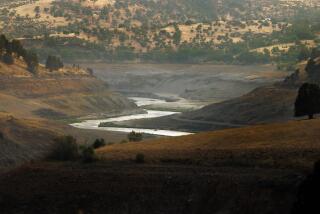Salmon, Dams Can Both Be Saved, Bush Says
BURBANK, Wash. — President Bush watched salmon wiggle up a ladder and slip down a bypass pipe at a hydroelectric dam in eastern Washington state on Friday, and pledged to do his part to help the restoration of the region’s salmon population.
Bush was careful not to claim credit for the marked increase in the numbers of salmon in recent years -- as much as tenfold for some species. But, as he wrapped up a two-day trip aimed at burnishing his environmental credentials, he stressed that his administration wants “to work with the local folks to revitalize the salmon runs.”
And, he said, “we can have good, clean hydroelectric power and have salmon restoration going on at the same time.”
As president, Bush has promoted policies that he says seek to balance the needs of business with environmental concerns. But many environmental groups charge that he favors industrial interests.
Bush praised officials and residents in eastern Washington for being collaborative about salmon preservation.
“The good news about what’s happening here is it looks like you’ve been able to bypass all the endless litigation, come up with solutions to the problem so that ... future generations can say, ‘These folks had a chance and they responded,’ ” Bush said.
Bob Lohn, regional administrator of the National Marine Fisheries Service, said the increase in the salmon population began in 1998, when conditions in the ocean off the Pacific Northwest became more favorable to the survival of young salmon. By 2000, scientists began to record a sharp spike in the number of salmon migrating upriver to their traditional spawning grounds.
“The low numbers in the past were due in part to poor ocean conditions, and the improvement is due in part to improved ocean conditions,” Lohn said.
Salmon live most of their lives in the ocean, but to spawn they migrate hundreds of miles upstream to the small streams where they were hatched. When the Columbia River and others in the area were dammed, the migration routes were interrupted and the salmon population dropped catastrophically.
Some environmental groups believe dams should be destroyed to restore the migration routes.
Bush said that with concerns about energy supplies running high, “we don’t need to be breaching any dams that are producing electricity, and we won’t.”
Bush toured the salmon preservation facilities at Ice Harbor Lock and Dam outside Burbank, where the number of adult salmon passing upstream has increased from 197,000 in 1992 to 391,000 last year.
The 670-megawatt plant, which when running at full capacity is large enough to supply two-thirds of the electricity needs of Seattle, was built in 1962 with salmon “ladders” designed to help adult fish swim up and over the dam.
But until a few years ago, juvenile fish heading toward the ocean had to pass through the plant turbines to migrate downstream. Bush observed a bypass that directs the young fish away from the turbines and through a pipe that deposits them downstream.
“We’ve had good adult passage for a number of decades. The problem has been the juvenile fish coming down,” Lohn said.
Bush said he supported the continued use of federal funding to “develop the strategies necessary to encourage salmon runs to increase.”
Environmental groups argue that the good news about the salmon population is temporary, and the administration’s efforts will be inadequate when ocean climate conditions change.
“The administration owes the citizens of the Northwest a comprehensive, effective recovery plan” for salmon, said Rebecca R. Wodder, president of American Rivers, an environmental group that favors breaching some of the region’s dams.
Bush on Thursday toured fire-ravaged areas of Oregon, using the visit to tout his administration’s plan to thin forests in the West. Environmentalists criticize that proposal as an effort to open protected forest to logging.
In both Oregon and Washington, he also attended fund-raisers for his reelection campaign. After Friday’s fund-raiser in Bellevue, Wash., he returned to his ranch near Crawford, Texas.
More to Read
Sign up for Essential California
The most important California stories and recommendations in your inbox every morning.
You may occasionally receive promotional content from the Los Angeles Times.










